If you’re looking into getting a pet snake (or if you already have one), it’ll most likely be a ball python. After all, ball pythons are the most popular pet snake species in the world – and for good reason!
Ball pythons are easy to care for, have a (generally) docile temperament, and come in hundreds of gorgeous morphs and variations.
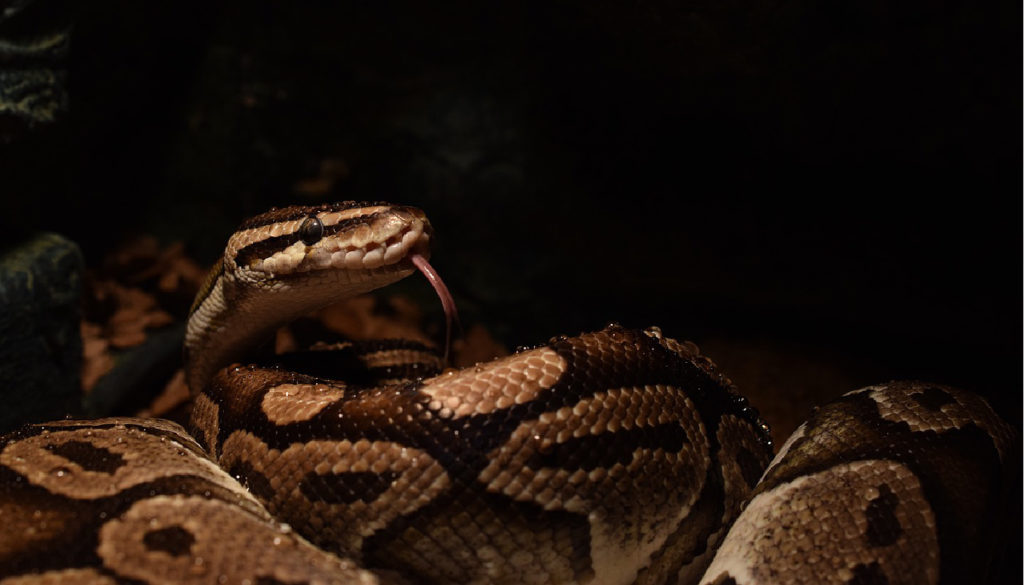
Although ball pythons are relatively easy to care for compared to some other snake species, it is important to learn everything you can about these fascinating creatures before bringing one home.
By taking the time to create a proper habitat and to understand the nature and needs of these charming reptiles, you’ll give your ball python the best chance to thrive, grow, and live a long and healthy life under your care.
This complete guide will teach you everything you need to know about ball python care and how to keep your snake healthy for years to come!
Quick Navigation
About Ball Pythons
Ball pythons, sometimes referred to as Royal pythons, are an ideal pet for first time snake owners. As we stated above, this is because they don’t require strict care & habitat needs and are generally peaceful snakes.
Native to western and central Africa, ball pythons inhabit both savannahs and forest terrains. They spend most of their time burrowing and hiding.
Ball pythons are crepuscular, which just means that they are most active at dawn and dusk instead of during the daytime. They have incredibly sensitive tongues, which they use to learn about the world around them.
There are many color and pattern variations among Ball pythons in the wild and in captivity, though there are no officially recognized subspecies.
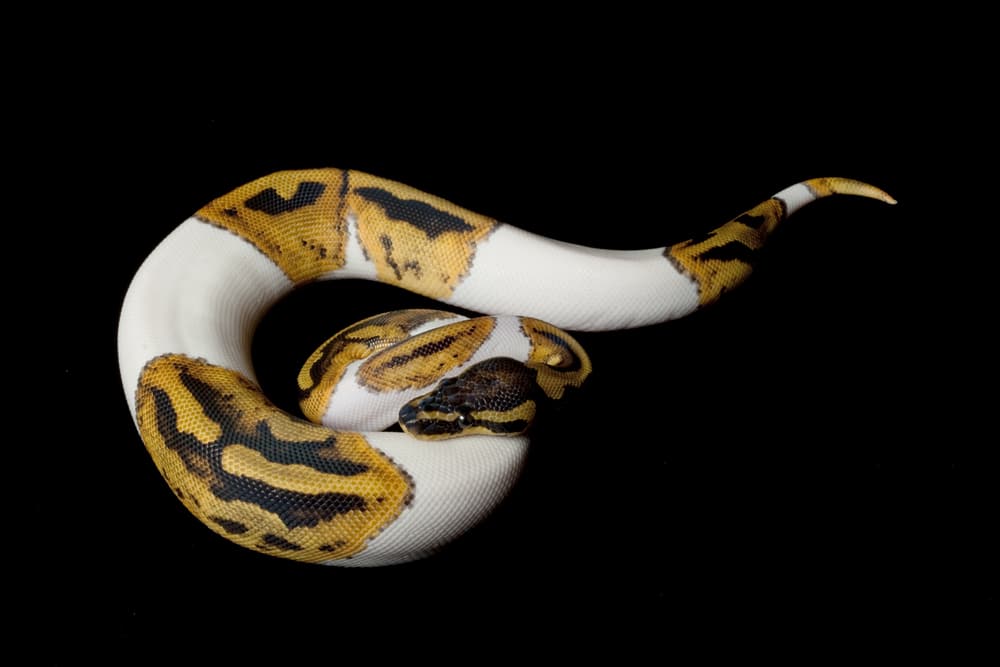
“Morphs”, as you will often hear, are pythons that were selectively bred to display unique color patterns. Regardless of how different each morph can appear, though, they are all the exact same species!
Normal ball pythons generally display earthy tones, which help them to blend in to their natural habitat.
Keeping Ball Pythons as Pets
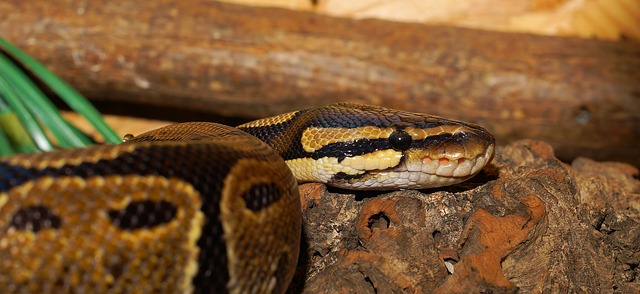
When considering any pet, long-term think is always key. You should be prepared to keep your snake for a long time.
Lifespan
The first thing you should probably consider is this: Ball pythons typically live for around 10 years in the wild.
However, well-kept captive ball pythons can live for 20 -30 years (and even longer, in some rare cases).
Remember this when considering whether it’s the right pet for you. Owning a ball python is a very long-term commitment.
Size
A Ball python can reach 3 to 4 feet in length when fully grown. They typically reach full size in about 3 years.
Pythons are constrictors. This means they wrap their body around prey, constricting their muscles tighter and tighter until the prey has suffocated. After that, the food is swallowed whole.
Ball pythons are usually easy to find, either through a local pet store or reputable reptile breeder.
Setting Up Your Ball Python Tank
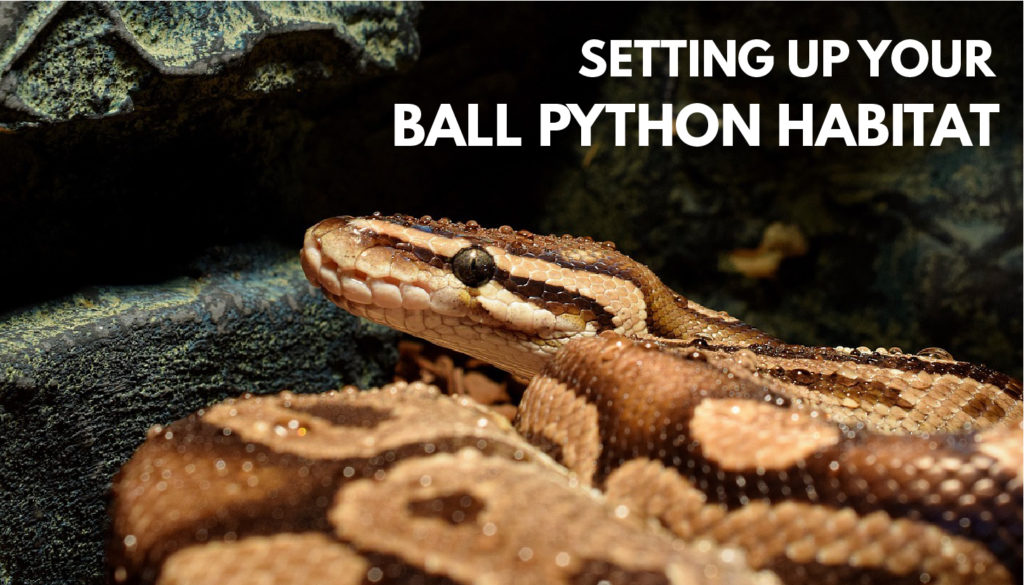
Before bringing home a new Ball python, you will need to set up its habitat.
While considered fairly low maintenance, these creatures still have certain requirements. Getting the habitat right is a key factor in giving your pet a happy, healthy life.
Types of Ball Python Tanks
You have a few options when it comes to the kind of container you can use to create your Ball python habitat.
1. Glass Tanks
Glass enclosures have historically been one of the most popular enclosures for Ball python hobbyists. They generally make good ball python enclosures as long as they are fitted with a suitable lid.
One great thing about glass tanks is that they provide ultimate visibility for observing your python in its habitat.
Glass tanks do come with some drawbacks, though.
One potential “con” with keeping your Ball python in this type of tank is that glass tends to get really cold in chilly temperatures. This can present challenges in keeping your snake’s habitat warm enough if you live in a cold climate.
Ball pythons also tend to feel very exposed in glass tanks, which can cause them to stop eating. A reptile hide is an absolute must – this allows your snake to escape the spotlight and feel more secure.
- Dimension: 20''L x 13.5''W x 6''H
- Your reptile will feel secure and safe in this reptile hides.
- Well made and sturdy, easy to clean.
2. Plastic Enclosures
Plastic tanks have become more popular in recent years, and some hobbyists recommend using a clear plastic tank to house your Ball python.
They are lighter and easier to move around than heavy glass tanks, and they also tend to be a lot less expensive.
Not just any plastic container will do, however. It should be strong and durable, with a lid that provides adequate ventilation.
It’s also important to choose material that won’t melt or present a fire hazard when subjected to any heating apparatuses you may install.
3. Wooden Vivariums
A number of wooden vivariums are available for keeping reptiles and other pets.
These usually have glass or plastic “doors” on the front for viewing and accessing the habitat.
Snakes may enjoy the solid walls of a wooden enclosure, since they are quite private animals that like being able to hide away from everything.
As long as a wooden vivarium is well-made, allows for proper ventilation, and has a secure opening, it can be a great place to house a Ball python.
A word of caution about wooden tanks, though – they tend to trap heat a bit too well and can become an oven if you’re not careful.
4. Home Made Setups
Some people make their own Ball python habitats – one of the obvious benefits of this include being able to customize it.
Creating hobbyists have built multi-level tanks, enclosures that fit into awkward spaces, and other elaborate custom-habitats.
This is a good option for people who are confident in their building skills, as well as their knowledge about the needs and nature of Ball pythons.
Be sure your enclosure has a secure top. The lid should fit tightly, and preferably have some type of locking mechanism.
Ball pythons are adept at escaping their enclosures if given the opportunity.
Mesh lids are a suitable option for most types of reptile tanks. They can withstand the high temperatures of heat lamps while allowing for sufficient airflow in the tank.
You can also buy ready-made Ball python habitats that include everything you need to get started.
These usually include lighting and heating setups, a hidebox and/or climbing branch, a substrate or liner, food and water dishes, and some other landscape or decor items.
Ball Python Tank Size
Ball pythons are pretty small when young, so a lot of first time owners think that they can put them in a tiny 10 gallon tank. I would definitely recommend going with a larger setup right from the beginning.
Ball pythons are relatively fast growers. At maturity, a tank size of 48″ x 24″ x 24″ is required. You may even have to get a bigger one down the road as your snake continues to grow.
For this reason, its generally best to just start out with the proper size instead of starting small and upgrading every few months.
Note: You also don’t want to go too big with the setup – ball pythons need places to curl up and feel secure. Too much open space can stress your snake out. This is where plenty of hides come in handy.
Ball Python Heating Requirements
Ball pythons are cold-blooded, so you’ll need to provide a heat source to create a healthy habitat.
You’ll want to create a proper thermal gradient for your ball python. This might sound complicated if you’ve never heard of it, but it’s actually pretty simple.
A thermal gradient just means that your tank needs to provide a range of temperatures for your snake, rather than one consistent temperature throughout.
This will give your snake the ability to warm up or cool down by moving from one side of the tank to the other.
Ideally, the “cool” side of your enclosure should be kept around 78 – 80 degrees Fahrenheit.
The hot side should be significantly warmer, between 88 – 94 degrees. This is sometimes called the “basking zone”.
Always use thermometers to ensure proper temperatures in the tank. The Zoo Med Digital Thermometer work pretty well for this purpose.
You should have one in the basking zone and another on the cooler side to ensure both sides of the tank stay at the right temperature.
How to Heat Your Tank
- Heat Lamps: Heat lamps are a great way to keep your Ball python habitat warm enough and to provide an ideal basking spot. These lamps are typically placed on top of a clear glass or wire mesh enclosure top. You’ll need a fixture to screw the heat bulb into; I recommend the Fluker’s Clamp Lamp since it comes with a dimmable switch.
- Ceramic Heaters: These heating elements screw into a regular light fixture, just like a heat bulb would. They do not produce any light, only heat. I recommend the Fluker’s ceramic heat emitter.
- Heat Pads: Heat pads are usually used as a secondary heat source, and can be particularly useful if your house gets cold and you have trouble keeping your snake habitat warm enough. They are typically placed underneath glass or plastic enclosures.
Most experts do not recommend using heat rocks for ball python habitats. They pose a burn risk to your animal.
Ball Python Humidity Requirements
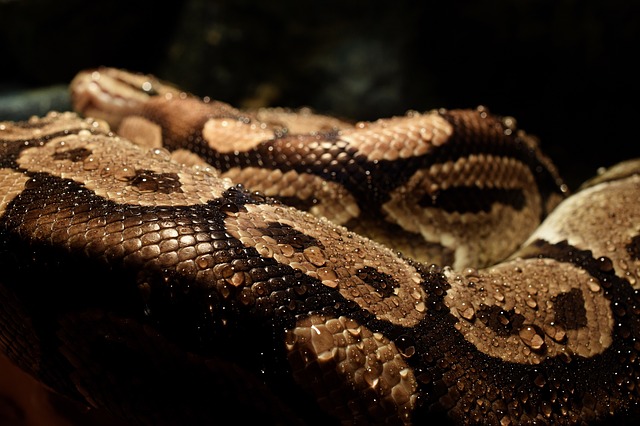
The ideal humidity level for a Ball python habitat is between 55 – 60%. This can usually be maintained simply by keeping a dish of water in your tank.
Use a simple hygrometer to measure this. If the humidity is too low, you can increase it by misting the tank with a water bottle. You can also use a larger water dish or add moist material such as moss to the tank.
Ball Python Lighting
Snakes don’t need special UV lighting like some reptiles (for example, bearded dragons). In fact, constant bright lighting can stress them out.
Simulate the light cycle in your pet’s natural habitat by providing 8 to 12 hours of “daylight” per day.
Keep all lighting outside the enclosure so your snake doesn’t burn itself.
Substrate for Your Ball Python Tank
There are quite a few options for the kind of flooring or liner you can use for your Ball python cage.
Aspen bark: Aspen shavings are a popular substrate and can be found at most pet stores or pet supply websites. It’s soft, attractive, and absorbent. Don’t use this type of substrate if you’ll be feeding your Ball python in its main enclosure. The light, fluffy bark shavings can be accidentally ingested along with prey. This can cause digestive issues (and possibly worse!) for your pet.
- Only the Best for You and Your Furry Friend: The ideal Bedding for your rabbit, guinea pig, gerbil,...
- 100% Heat-Dried All Natural Aspen Shavings: Made in the USA without any harmful dyes, chemicals or...
- Comfy Is Key: Super cozy and fluffy but still super absorbent; We have developed this product for...
Beech Bark: Chips of beech wood can also make a great looking substrate for your python habitat. It’s sturdier many other organic substrate options and doesn’t present as much of an accidental ingestion risk.
Newspaper: Many hobbyists and breeders choose to use newspaper to line their Ball python habitat. Newspaper is usually free (or at least very cheap), and you don’t have to go anywhere special to obtain it. The downside of using this kind of substrate is that it’s not very nice looking and it has to be changed a lot to keep your tank clean.
Coconut Fiber: Coconut fiber is a cheap and absorbent option for Ball python enclosure substrate. It tends to soak up moisture (and bad odors!) quite well. Just take the same care you would with Aspen bark, for the same reason.
- 🐍 CREATE A HEALTHY HABITAT for your ball python or leopard gecko with ReptiChip Coconut Substrate...
- 🐍 72-QUART COMPRESSED BRICK equals 10 lbs of safe, comfortable reptile bedding for professional...
- 🐍 ODOR-ABSORBING ReptiChip Coco Substrate encapsulates waste product, making your bearded dragon,...
Cypress Mulch: Cypress Mulch is another attractive option for your snake habitat, especially if you favor more natural-looking substrates. Many hobbyists like Cypress mulch as a substrate because of its absorbency.
- All natural green "product"
- Recommended terrarium substrate for many species of snakes, lizards, land turtles, tortoises, frogs,...
- All natural green" product"
Reptile Carpet: You can purchase carpet strips made specifically for use in reptile cages. These are inexpensive and not bad looking. Many experts recommend steering clear, though, since they can be difficult to clean.
Reptile Mats: Some pet stores and sites sell special mats for snake habitats. Some are quite beautiful, made to look like real natural materials such as moss or grass. If you go this route, be sure to get something that is absorbent and easy to clean.
Ball Python Substrates to Avoid
These types of substrate aren’t ideal for your Ball python habitat.
Sand: Sand doesn’t absorb moisture very well, and usually just ends up being messy and smelly. It can also play host to dangerous bacteria.
Cedar and Pine: The oils in both cedar and pine bark can be harmful to snakes. Never use either as your substrate.
Objects and Decor
It’s important that your Ball python tank isn’t just a big, open space.
Snakes need to have places to curl up and hide away. Being too exposed can make your snake feel vulnerable and threatened.
Placing the right objects in the tank can help your pet feel more comfortable, as well as serving other key functions.
Hiding places
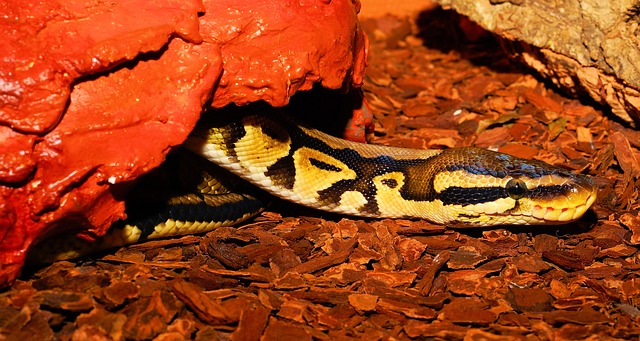
It’s essential for your ball python’s health and well-being that there is a hidebox of some sort in its enclosure.
In nature, these creatures spend a good portion of their days hiding out in whatever dark place they can find.
In captivity, they need to be provided with a hidebox for this purpose.
Purchase a pre-made hidebox from pet stores or create your own out using a hollow log, flower pot, or other household object that can safely provide cover for your snake.
I’d recommend something simple like the Pangea hide box – it is easy to clean and affordable.
- Perfect plastic reptile hides for terrestrial reptiles: This snake hide box is the perfect addition...
- Cost-effective snake hides: These snake enclosure accessories are the perfect addition to your...
- Durable: These reptile hideout boxes are made of heavy 1/8" thick plastic and can withstand just...
Decor to Climb
Snakes also require something to climb around on.
A climbing branch should do nicely (bonus: some climbing branches can double as hiding spots).
A strategically placed branch underneath a heat lamp can provide a nice basking spot for your pet.
Greenery
Placing some greenery in the enclosure helps provide cover for your snake. It’s also a nice way to give your tank a more natural look.
Rocks
You can place rocks in the tank for your snake to climb around on. Tall rocks make nice basking places.
You can buy real and imitation rocks at pet stores.
The nice thing about this is that they are specifically made to suit snake enclosures.
You can also use rocks you find in nature. Just be sure to clean and sanitize them first. Also, take care to ensure they are sturdy and won’t fall over on your pet.
Ball Python Diet Guide
Ball pythons are carnivorous, feeding on various types of live prey in the wild.
The size of prey they eat depends on their own size; Ball pythons graduate to eating larger prey as they grow.
Foods You Can Feed to Your Ball Python
In captivity, they are most commonly fed small rodents, such as rats or mice.
Baby pythons can be fed baby rodents.
Adults can eat adult mice or rats, with some hobbyists including small chickens and rabbits in their python’s diet.
Live Food
Some owners prefer to provide live food for their captive snakes. It can be fascinating to observe a version of the way these animals hunt and kill their prey in the wild.
That said, feeding your snake live food can present a hazard. Caged rodents, particularly rats, can inflict some serious damage to your snake with their teeth and claws.
In addition, live food always presents the risk of introducing parasites or disease to your snake.
Overall, I wouldn’t recommend regularly feeding live rodents unless absolutely necessary.
Frozen Food
You can feed your Ball python frozen rodents. This is a much more convenient and safe way to fulfill your snake’s dietary needs.
Just thaw the food thoroughly before offering it to your snake. It’s best if warm.
Freshly Killed Food
While it’s certainly not for everyone, some keepers prefer to feed their snake fresh prey that has recently been killed.
Ball pythons don’t need to be fed any special supplements, as long as they are given a healthy diet.
How Often Should I Feed My Ball Python?
A juvenile Ball python will need to eat about once per week. Fully grown Ball pythons usually eat a bit less, and can go up to two weeks between feedings.
Each snake will vary slightly, and you’ll get to know what the ideal period between feedings is as you observe your own snake. If it seems uninterested in food, wait a bit longer between feedings. Even snakes can become obese and suffer health issues if they are overfed.
You should feed your snake in a separate tank from their enclosure if at all possible. This can minimize the risk of your pet accidentally ingesting an object from the tank such as a bit of false greenery or a chunk of substrate material.
It’s also a good idea to train your snake that food only comes when he or she is in the feeding tank. Feeding a Ball python in its regular habitat can result in confusion.
Your snake might think it’s about to be fed when you’re merely reaching in to change out the water dish.
Ball Python Hydration
It’s important to make sure your Ball has plenty of fresh water to drink. The dish should be large enough for your ball python to soak in.
Your snake will probably use its water container as a restroom, too, so be prepared to change the water regularly.
Handling A Ball Python
One of the most exciting parts about having a pet snake is being able to handle him or her if you choose to.
While Ball pythons can certainly be held, take time to establish a bond of trust with your snake before simply reaching in and grabbing it.
Ball pythons tend to be somewhat anti-social by nature, and yours may not welcome your early attempts at handling.
Follow these tips to facilitate a better experience for you and your pet.
- Start slowly – Don’t try to handle your new Ball python for the first couple of weeks after you bring it home. Give it time to get accustomed to its new habitat and begin to develop a regular feeding schedule.
- Show your snake that you can be trusted – Be consistent with care and feeding, so that your snake becomes accustomed to your presence and makes positive associations with you.
- Wash your hands – This is to remove any harmful substances from your skin, as well as to take away any smells that your snake might mistake for lunch.
- Relax – Reach out to your snake slowly, and don’t make sudden movements.
- Let the snake know what’s going on – Most experts use something solid yet soft, like a paper towel roll, to give the snake a gentle tap on its head. Set a routine of doing this each time you handle your snake in order to train it to recognize that handling time is different than feeding time. This is of particular importance if you feed your snake in the main habitat.
- Handle with care – Pick your snake up with both hands. Use one to hold your snake’s head, the other to support its body. Picking up a snake by its tail or lower body can cause serious injury.
- Anticipate your snake’s behavior – Your Ball python will naturally look for something to wrap around and stabilize itself. If your snake begins to encircle your arm or shoulders, don’t panic. This is natural, and nothing to be scared of.
- Protect your neck – That said, a large snake wrapping itself around your neck presents obvious issues. Don’t allow your snake to wrap around your neck. If it starts to, use your hand or arm to put space between your pet and your neck until you can get it re-positioned.
- Take care with kids – If you’re letting kids handle your snake, take steps to protect both parties. Help kids to hold the snake properly so it doesn’t get injured from being squeezed, dropped, or otherwise mishandled. Help the child with safe handling techniques so that the snake doesn’t become agitated or wrap around the child’s neck.
- Use the buddy system – If your snake is medium to large sized, it’s best to err on the side of caution and never handle it alone. That way, your friend can intervene if you find yourself getting wrapped up too tightly. If you have to unwind a snake from your own or someone else’s body, start with the tail (this is the least muscular part of the snake, making it the easiest to control).
- Respect your snake’s preferences – Your snake will not want to be handled for a day or two after eating. This is because they are busy digesting their meal and want to be left alone while doing so. Also, don’t handle your snake while it’s molting. Shedding skin around the eye area might inhibit your snake’s already-limited visibility, raising the risk for bite incidents.
Eventually, many Ball pythons seem to enjoy being held by their trusted handler. Every snake is different, though, and some may require more time and care.
Ball Python Bites – What To Do
Wait, what? Yes, it can happen. While Ball pythons are indeed constrictors, they are definitely capable of biting. Here’s what you should know about that.
Ball pythons are not aggressive, and snakes are not capable of feeling anger or malice. Everything they do is instinctual. If yours bites you, it’s simply because they feel threatened or momentarily think you are food.
They will probably just let go. If your snake does sink its teeth into you, it’s likely to let go right away. A Ball python should quickly realize you’re not actually a tasty rodent.
But, they might not… If your snake doesn’t let go right after a bite, resist the urge to rip it off quickly. Doing so could actually tear its teeth out, injuring your snake and making your own injury much worse. It’s most likely that your snake is simply stuck. Try to gently pull the snake’s head forward (since their teeth slant to the rear) to dislodge it.
Use a little mouthwash. If you find yourself trying to get your Ball python to unlatch itself, pour a bit of alcohol-based mouthwash on it. The strong smell and flavor usually prompts snakes to let go right away.
You’ll be just fine. Ball python bites usually amount to a few tiny abrasions that need little more than a good cleaning. It probably won’t hurt much, either, and should heal quickly. They are not even a tiny bit venomous, so don’t worry about that at all.
How to Minimize the Risk of a Ball Python Bite
- Feed your pet regularly. Provide regular meals to your snake. A hungry Ball python is much more likely to mistake your hand for food than one who ate a few days ago.
- Don’t smell delicious. Always wash up (many hobbyists slather on some hand sanitizer as an added precaution) before handling your snake.
- Use a hook. Using a snake hook to take your python out of its tank is a good way to avoid accidental bites, giving you an added measure of control and helping your snake to know it’s not feeding time.
- Feed your python in a separate tank. If your snake knows food only arrives when it’s in the feeding enclosure, it’s less likely to strike when in its regular tank.
Ball Python Shedding
Your Ball python should shed its skin every 4 – 6 weeks.
As your snake prepares to shed, its markings will begin to look dull. Eventually, the old skin will turn a milky-whitish color as it begins to separate itself.
The snake’s eyes will also cloud over during this period, something you may hear breeders refer to as being “in blue.”
Ball pythons usually shed on their own. However, there are a couple things you can do to help things along if your snake is having trouble.
First, increase the humidity in your tank. If that doesn’t seem to do the trick, you can soak your snake in water for a couple of hours to aid the shedding process.
Cleaning the Habitat
Keep your Ball python’s home clean and sanitary by performing regular cleanings.
Daily Maintenance
Remove any excrement or other visible messes from the enclosure. Empty, clean, and refill the water dish. Remove and replace any substrate that has become wet or soiled.
Weekly Maintenance
Every week or so, clean and disinfect all the items inside the habitat. You can make a diluted bleach solution (with a water to bleach ratio of about 20 to 1).
Rinse, dry, and allow all furnishings and decor items to air out before returning them to the tank. If they still smell like bleach, rinse and dry again.
It’s easier and involves less guesswork, though, to purchase a product specifically made for sanitizing your snake habitat.
As Needed
Clean and sanitize your entire enclosure. A good time to do this is when your snake is in its feeding tank.
Pythons are Escape Artists
Despite your best efforts, there is always a possibility that your ball python could escape its enclosure.
This usually happens when someone accidentally leaves the enclosure top unsecured.
There are a lot of things around your home that can be hazardous to your snake, so it’s important to try and locate your pet right away.
- If you have other pets in the home, such as dogs or cats, put them outside or in another secure place until you locate your python. This is for the safety of all your pets. Smaller pets, like cats or very small dog breeds could be mistaken for prey by a large Ball python. Larger pets could attack your snake.
- Let everyone in your household know your snake is on the loose right away. While you might be hesitant to admit that your snake got out, it’s in everyone’s best interest (including your python) to have full disclosure.
- Snakes are naturally drawn to heat and will often seek it out upon escaping. Consider heat sources that might attract yours. Check heater vents, space heaters, appliances, and any other place in your home where there is something generating heat.
- Another place to look for a wayward Ball python is in the bathtub, the sink, and especially the toilet. To a Ball python, your toilet probably seems like a nice place for a good soak. It’s also not unheard of for snakes to ball themselves up behind the toilet tank.
- Use flashlight to look underneath and behind furniture, appliances, and other objects in your home. Your snake may very well seek out a hiding place away from light and noise.
- Missing snakes often hide inside boxes, boots, handbags, drawers, and other cozy spots.
- Ideally, you’ve patched up any holes in your walls and secured any other places a snake could potentially get into (such as open ducting or pipes, etc). If not, check these places after thoroughly searching everywhere else. After you’ve located your snake, seal these up right away.
- Placing boards, bricks, rocks, and other objects on top of a loose lid probably isn’t going to help. This tactic might work on a small snake, but as your python grows it will become incredibly strong. Adult Ball pythons can push through these obstacles, and possibly injure themselves in the process.
- Don’t underestimate your snake’s ability to squeeze through tight spaces. Baby snakes are notorious for escaping hinged enclosure tops by squeezing through the gaps. Make sure your tank is secure. If you’re not sure, talk to an expert.
- You may be able to lure your snake out of hiding with fresh prey.
A Few Final Ball Python Care Tips
- It’s probably best that you steer clear of attempting to breed your pet ball python. For the health of your snake and any potential offspring, this is best left to the experts. If breeding is something you’re interested in, conduct extensive research before you begin. Make sure you can provide for all the unique needs of a breeding pair of Ball pythons, and that you can accommodate the eggs and eventual babies. This can be costly and time consuming – so it’s not something that should not be entered into lightly or because it seems fun.
- Unless you are breeding, it’s not advisable to place any other snakes in your snake’s enclosure. While you may see multiple ball pythons together in a tank at the pet store, this isn’t ideal. Even though a pair of Ball pythons can peacefully coexist, having a tankmate can cause unnecessary stress to your pet. If you do decide to house more than one Ball python, make sure you have a large enough enclosure and provide multiple hide spots and basking areas so they are not competing for space.
- Always wash your hands thoroughly after handling your snake or any of the objects in the tank.
Last update on 2025-10-13 / Affiliate links / Images from Amazon Product Advertising API





Fantastic guide, thank you.